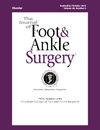Tranexamic acid and its outcomes in foot and ankle surgical procedures: A meta-analysis
IF 1.3
4区 医学
Q2 Medicine
引用次数: 0
Abstract
As the indication for Tranexamic Acid (TXA) evolves, this study serves as a comprehensive review of the literature evaluating the impact of TXA in foot and ankle surgery. Preferred Reporting Items for Systematic Reviews and Meta-Analyses (PRISMA) guidelines were followed to evaluate TXA benefits and safety profile in foot and ankle surgery. Inclusion criteria included TXA use in foot and ankle surgery with at least one of the outcomes: wound complications, infections, postoperative bleeding, and risk of thromboembolic events (VTEs). MEDLINE/PubMed and Cochrane Library were searched for eligible studies from inception through April 1st, 2023, utilizing keywords: tranexamic acid with any combination of calcaneal, foot and ankle, total ankle arthroplasty. Risk of bias was assessed by Cochrane Robvis and ROBIN-1 tools. Cochrane Review Manager synthesized individual study data. Of 36 studies reviewed, 7 met inclusion criteria. There was a total of 691 subjects between the two groups: TXA (n = 338) and non-TXA (n = 353). Though statistically not significant, wound complications and postoperative infections were lower in the TXA group compared to non-TXA (15.4 % versus 26.1 %, p = 0.21) and (4.9 % vs. 9.4 %, p = 0.20), respectively. The TXA group experienced statistically lower blood loss compared to the non-TXA group (149 vs. 156 ml, p = 0.002), and showed a lower hemoglobin drop level (122 vs. 138, p = 0.005). TXA use in foot and ankle surgery demonstrated a trend towards lower overall wound complications, risk of infections, risk of postoperative bleeding, with no increased risk for VTEs.
氨甲环酸及其在足部和踝关节外科手术中的疗效:一项荟萃分析。
随着氨甲环酸(TXA)适应症的发展,本研究对评估TXA在足踝手术中的影响的文献进行了全面的综述。遵循系统评价和荟萃分析(PRISMA)指南的首选报告项目来评估足部和踝关节手术中TXA的益处和安全性。纳入标准包括在足部和踝关节手术中使用TXA,并伴有至少一项结果:伤口并发症、感染、术后出血和血栓栓塞事件(vte)风险。检索MEDLINE/PubMed和Cochrane图书馆从成立到2023年4月1日的符合条件的研究,使用关键词:氨甲环酸与跟骨、足部和踝关节的任何组合,全踝关节置换术。采用Cochrane Robvis和ROBIN-1工具评估偏倚风险。Cochrane Review Manager综合了个人研究数据。在36项研究中,有7项符合纳入标准。两组共691例受试者:TXA (n = 338)和非TXA (n = 353)。虽然没有统计学意义,但与非TXA组相比,TXA组的伤口并发症和术后感染发生率分别较低(15.4%比26.1%,p = 0.21)和(4.9%比9.4%,p=0.20)。与非TXA组相比,TXA组的失血量在统计学上较低(149 vs 156 ml, p = 0.002),血红蛋白下降水平较低(122 vs 138, p = 0.005)。在足部和踝关节手术中使用TXA显示出降低整体伤口并发症、感染风险、术后出血风险的趋势,没有增加静脉血栓栓塞的风险。临床证据等级:3。
本文章由计算机程序翻译,如有差异,请以英文原文为准。
求助全文
约1分钟内获得全文
求助全文
来源期刊

Journal of Foot & Ankle Surgery
ORTHOPEDICS-SURGERY
CiteScore
2.30
自引率
7.70%
发文量
234
审稿时长
29.8 weeks
期刊介绍:
The Journal of Foot & Ankle Surgery is the leading source for original, clinically-focused articles on the surgical and medical management of the foot and ankle. Each bi-monthly, peer-reviewed issue addresses relevant topics to the profession, such as: adult reconstruction of the forefoot; adult reconstruction of the hindfoot and ankle; diabetes; medicine/rheumatology; pediatrics; research; sports medicine; trauma; and tumors.
 求助内容:
求助内容: 应助结果提醒方式:
应助结果提醒方式:


